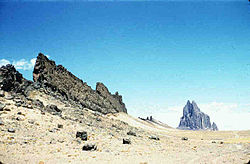- Dike (geology)
-
 Banded gneiss with dike of granite orthogneiss.
Banded gneiss with dike of granite orthogneiss. An intrusion (Notch Peak monzonite) inter-fingers (partly as a dike) with highly-metamorphosed host rock (Cambrian carbonate rocks). From near Notch Peak, House Range, Utah.
An intrusion (Notch Peak monzonite) inter-fingers (partly as a dike) with highly-metamorphosed host rock (Cambrian carbonate rocks). From near Notch Peak, House Range, Utah.
A dike or dyke in geology is a type of sheet intrusion referring to any geologic body that cuts discordantly across
- planar wall rock structures, such as bedding or foliation
- massive rock formations, like igneous/magmatic intrusions and salt diapirs.
Dikes can therefore be either intrusive or sedimentary in origin.
Contents
Magmatic dikes
. An intrusive dike is an igneous body with a very high aspect ratio, which means that its thickness is usually much smaller than the other two dimensions. Thickness can vary from sub-centimetre scale to many metres, and the lateral dimensions can extend over many kilometres. A dike is an intrusion into an opening cross-cutting fissure, shouldering aside other pre-existing layers or bodies of rock; this implies that a dike is always younger than the rocks that contain it. Dikes are usually high angle to near vertical in orientation, but subsequent tectonic deformation may rotate the sequence of strata through which the dike propagates so that the latter becomes horizontal. Near horizontal, or conformable intrusions, along bedding planes between strata are called intrusive sills.
Sometimes dikes appear as swarms, consisting of several to hundreds of dikes emplaced more or less contemporaneously during a single intrusive event. The world's largest dike swarm is the Mackenzie dike swarm in the Northwest Territories, Canada.[1]
 Shiprock, New Mexico, the volcanic neck in the distance, with radiating dike on its south side. Photo credit: USGS Digital Data Series
Shiprock, New Mexico, the volcanic neck in the distance, with radiating dike on its south side. Photo credit: USGS Digital Data Series
Dikes often form as either radial or concentric swarms around plutonic intrusives, volcanic necks or feeder vents in volcanic cones. The latter are known as ring dikes.
Dikes can vary in texture and their composition can range from diabase or basaltic to granitic or rhyolitic, but on a global perspective the basaltic composition prevails, manifesting ascent of vast volumes of mantle-derived magmas through fractured lithosphere throughout Earth history. Pegmatite dikes are extremely coarse crystalline granitic rocks often associated with late-stage granite intrusions or metamorphic segregations. Aplite dikes are fine grained or sugary textured intrusives of granitic composition.
Sedimentary dikes
 Clastic dike (left of notebook) in the Chinle Formation in the Island In the Sky District of Canyonlands National Park, Utah.
Clastic dike (left of notebook) in the Chinle Formation in the Island In the Sky District of Canyonlands National Park, Utah.
Sedimentary dikes or clastic dikes are vertical bodies of sedimentary rock that cut off other rock layers. They can form in two ways:
- When a shallow unconsolidated sediment is composed of alternating coarse grained and impermeable clay layers the fluid pressure inside the coarser layers may reach a critical value due to lithostatic overburden. Driven by the fluid pressure the sediment breaks through overlying layers and forms a dike.
- When a soil is under permafrost conditions the pore water is totally frozen. When cracks are formed in such rocks, they may fill up with sediments that fall in from above. The result is a vertical body of sediment that cuts through horizontal layers: a dike.
 Magmatic dikes radiating from West Spanish Peak, Colorado, USA
Magmatic dikes radiating from West Spanish Peak, Colorado, USA
See also
- Batholith
- Ring dike
- Fissure vent
- Laccolith
- Runamo, formerly interpreted as a runic inscription.
- Dike swarm
- Sill
References
- ^ Supressing Varying Directional Trends Retrieved on 2007-07-28
Igneous rocks by composition Type Ultramafic
< 45% SiO2Mafic
45-52% SiO2Intermediate
52–63% SiO2Intermediate-Felsic
63–69% SiO2Felsic
>69 % SiO2Volcanic rocks:
Subvolcanic rocks:
Plutonic rocks:Categories:- Sheet intrusions
- Volcanology
- Igneous petrology
Wikimedia Foundation. 2010.




